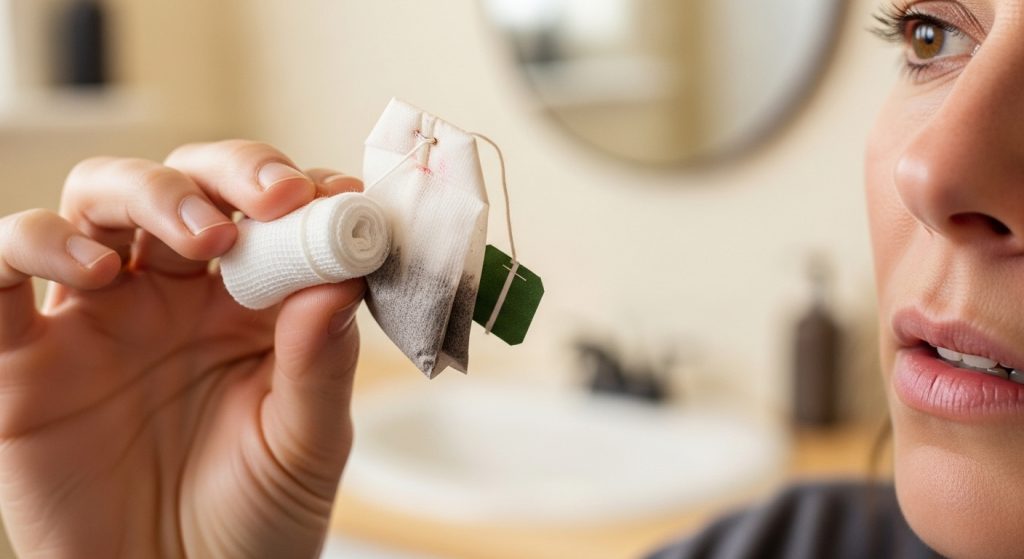Patients often experience bleeding after tooth extraction, which can cause anxiety and prompt actions like excessive rinsing or spitting that may complicate healing. Bleeding is a normal and essential part of the healing process, marking the beginning of recovery as the body works to protect the extraction site.
In this guide, we will explain normal bleeding after tooth extraction, how to manage this phase calmly, recognize normal bleeding versus emergencies, and know when to contact a dentist.
Why We Experience Bleeding After Tooth Extraction
When a tooth is removed, the socket is an open wound. The body’s immediate response is to initiate the clotting cascade, forming a crucial blood clot that acts as a natural, protective barrier over the exposed bone and nerves. This clot is the foundation upon which new bone and soft tissue will form. Interrupting this clot, either through vigorous activity or improper care, is the primary reason bleeding persists or complications, such as dry socket, occur.
Why Is Tooth Extraction Needed? – Dentist Walk-In Toronto | Walk-In Dental Clinic | emergency dental
Normal Bleeding: What to Expect in the First 48 Hours
Most people overestimate the amount of blood they are losing because a small amount of blood mixed with a large amount of saliva creates a deceptively alarming pink or red tint. Understanding the tooth extraction recovery timeline and the nature of a healthy healing process is key to minimizing anxiety.
Phase 1: Immediate Control and Initial Oozing (0–24 Hours)
The true bleeding from the extraction site should be controlled immediately by the firm pressure of the gauze pack applied by your dentist. The initial 30 minutes to one hour of continuous pressure is designed to facilitate the formation of a robust, stable blood clot. After removing the initial gauze following tooth extraction, expect a normal flow of blood or pink/red-tinted saliva, which may persist through the first day and into the next morning.
A healthy clot appears as a dark red or maroon, jelly-like mass filling the socket, acting as a protective “scab” and should not be mistaken for a problem. Saliva’s fibrinolytic properties and volume can exaggerate the appearance of blood, making it seem more profuse; however, if gauze isn’t soaked within 10–15 minutes, it’s likely just oozing, not active bleeding.
Phase 2: Stabilization and Resolution (24–48 Hours)
By the second day, the blood clot should be stabilized, and bleeding should have significantly decreased. Active bleeding should have stopped completely, though a light pink tinge may appear when gently spitting, but the mouth should not fill with blood. Swelling and discomfort typically peak on the second and third days, which can be mistaken for ongoing bleeding; however, this is usually just residual discoloration or swelling, not active bleeding.
Proactive Home Management: Proven Techniques for Control
The power to manage normal post-extraction bleeding is largely in your hands:
The Gauze and Tea Bag Method
Pressure is the most effective way to help the body form a stable clot. Do not use flimsy cotton wool or tissues, as these can disintegrate and irritate the wound:

- The Gauze Technique: Fold a clean, fresh piece of damp gauze into a pad thick enough to cover the socket. Place it directly over the extraction site and bite down firmly, steadily, and continuously for 45 to 60 minutes. During this time, you must remain still, limit conversation, and avoid checking the gauze, as movement breaks the fragile clot threads.
- The Black Tea Bag Advantage: If the flow persists after trying the gauze technique a second time, a black tea bag can be an excellent alternative. Black tea contains tannic acid, a natural astringent and vasoconstrictor that helps capillaries contract and promotes faster clotting. Dampen a standard black tea bag with cool water, place it over the socket, and bite down for 30 minutes.
Positioning and Rest
Your body position significantly impacts blood flow to the tooth extraction site. For the first 24–48 hours, keep your head elevated above heart level by using several pillows while resting or sleeping, leveraging gravity to reduce blood pressure at the wound and minimize bleeding. Avoid strenuous activities, such as heavy lifting, bending, or intense exercise, for at least 48 hours, as increased heart rate and blood pressure can increase the risk of bleeding.
What to Avoid to Protect the Clot!
Disrupting the blood clot is the most common cause of prolonged bleeding after tooth extraction, and it can lead to the painful complication known as dry socket.
| What to Avoid | Reason for Avoidance | Duration of Avoidance |
| Spitting or Rinsing Vigorously | The suction and pressure can pull the clot right out of the socket. | Minimum of 24 Hours |
| Using a Straw | The muscular action and negative pressure created by sucking are highly effective at dislodging the clot. | Minimum of 7 Days |
| Smoking or Vaping | Nicotine restricts blood vessels (hindering healing), and the sucking motion can dislodge the clot. | Minimum of 48–72 Hours |
| Consuming Hot Liquids or Food | Heat can cause blood vessels to expand, which promotes increased bleeding. | For the First 24 Hours |
| Touching the Extraction Site | Never probe the socket with your tongue, fingers, or any object. | Until Fully Healed |
Contact Us for Help!
Are you experiencing bleeding after a tooth extraction or other dental emergencies?
Contact us immediately to discover a solution, ease your mind, and perfect your smile!
When to Call a Dentist: Identifying a Dental Emergency!
While most bleeding after tooth extraction is manageable at home, according to Cochrane Library, it is essential to recognize the symptoms that indicate emergency dental issues, clot failure, or a condition that requires professional intervention. If you have diligently followed the home care instructions for at least one hour and the flow has not subsided, please contact your dentist immediately.

Red Flags: A Quick Guide to Seeking Professional Care!
If you’re experiencing bleeding after tooth extraction and notice any of the following signs, stop all home care methods and visit an emergency dentist. The goal is to prevent excessive blood loss, address potential clot failure, or treat an underlying infection.
| Symptom Category | Red Flag Indicator | Why You Must Call Your Dentist |
| Active Bleeding | Gauze Saturation: The gauze pad becomes completely soaked through with bright red blood within 10–15 minutes of applying firm pressure, and this continues for over an hour. | This indicates a persistent leak from a blood vessel or a complete failure of the clot to form or stabilize. |
| Duration of Bleeding | Bleeding Beyond 48 Hours: Any level of continuous active bleeding (not just a pink tint) that persists past the second day. | Prolonged haemorrhage suggests an underlying issue, possibly a systemic condition or a deep vascular trauma. |
| Clot Integrity | “Liver Clot” Formation: A very large, dark, gelatinous clot forms and hangs out of the socket, but the socket underneath continues to weep or fill with blood. | This “currant jelly clot” is an unstable, ineffective clot that requires removal and replacement with a stable dressing by a professional. |
| Systemic Symptoms | Feeling Faint/Weak/Dizzy: Experiencing signs of shock or excessive blood loss, such as lightheadedness, pallor, or a rapid, weak pulse. | This is a medical emergency requiring immediate assessment to prevent serious complications. |
| Pain and Infection | Worsening Pain or Fever: Severe, unrelenting pain that increases after day three (potential Dry Socket), or a fever above 100.4∘F (38∘C) accompanied by pus or foul odour. | These signs indicate a complication (infection or dry socket) that requires medicated dressing, cleaning, and possibly antibiotics. |
Understanding Risk Factors for Prolonged Bleeding
Certain pre-existing conditions or medications can increase the risk of prolonged or excessive bleeding after tooth extraction, so it’s critical to inform your dentist before the extraction if you have or take any of the following: anticoagulant medications, also known as “blood thinners,” which may require coordination with your physician to adjust dosages.
Antiplatelet drugs, such as Aspirin, or high doses of Ibuprofen taken regularly, and systemic conditions like haemophilia, von Willebrand disease, liver dysfunction, or certain cancers that affect clotting.
Complex extractions, such as impacted wisdom teeth, those with fused roots, or emergency tooth extractions, may cause more tissue trauma, leading to a longer period of manageable oozing.
Patience Is Key in Bleeding After Tooth Extraction!
Recovering from a tooth extraction requires patience and strict adherence to post-operative instructions. While the sight of blood can be stressful, a calm approach and knowledge of the basic first-aid steps will resolve the vast majority of bleeding issues. By recognizing the difference between the minor, expected ooze and a true emergency, you can ensure your healing process is smooth, safe, and free from unnecessary panic.
FAQ
Is bleeding for 24 hours normal after extraction?
Yes, mild oozing or spotting (pink-tinged saliva) in the first 24 hours can be normal. But heavy bleeding, constant streaming, or soaking gauze repeatedly is not.
How long should clotting take?
A stable clot should form within the first few hours (2–4 hours) with proper pressure. Severe bleeding should diminish in that timeframe.
What is a “liver clot” and why is it dangerous?
A “liver clot” is a soft, dark-red, jelly-like clot that may lie loosely in the socket. It’s not firmly attached, and if disturbed, it can lead to renewed bleeding.
Can I use a tea bag to stop bleeding?
Yes. Black tea contains tannic acid, which can aid in blood clotting. Place a moistened tea bag over the socket and bite gently for about 30 minutes.
Should I avoid certain medicines after extraction?
If possible, avoid NSAIDs like ibuprofen (unless prescribed), especially in high doses, as they can impair platelet function. Discuss blood thinners or anticoagulants with your dentist or physician before extraction.
Can I rinse my mouth with salt water to stop the bleeding?
No, absolutely not during the first 24 hours. It can dislodge the new blood clot and restart bleeding. Begin gentle warm salt water rinses after 24 hours to lightly soak the area without aggressive swishing, keeping the site clean.
Have you ever experienced bleeding after tooth extraction? How did you subdue the bleeding and manage during the recovery? Share your thoughts in the comments and join the conversation.





